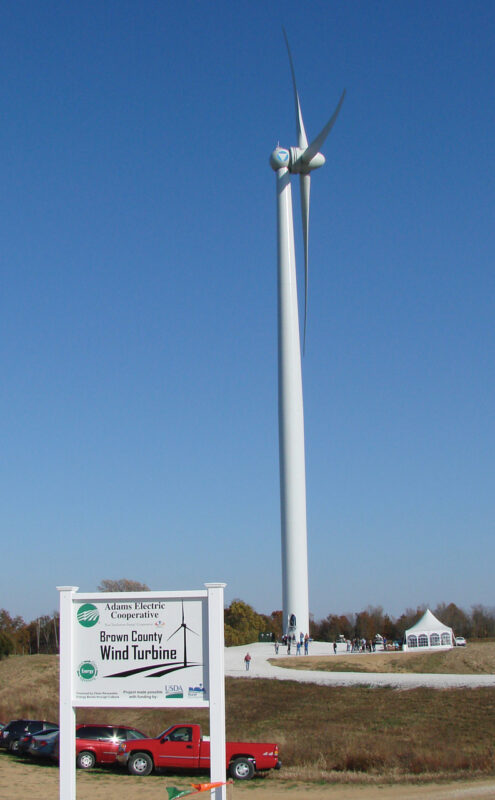
In April 2024, the U.S. Department of Energy unveiled a slate of groundbreaking renewable energy projects under its Energy Improvements in Rural or Remote Areas (ERA) program. . The program is now open for funding again, for applicants in rural areas, including but not limited to, local units of government, non-profits, for-profit businesses, rural electric cooperatives, and more!
Among the success stories was Adams Rural Electric Cooperative, one of just 19 energy projects (including six rural electric cooperative projects) nationwide to secure funding in 2024. The Adams Electric project serves as inspiration for other rural communities that seek to take advantage of another recently opened round of ERA funding opportunity for energy projects in rural areas.
ERA Funding Supports Solar and Wind for Adams Electric Cooperative in Illinois
Adams Electric’s ambitious project involves the construction of a 1 MW wind turbine and a 1 MW solar array. Over their 25-year lifespan, these installations are expected to cut greenhouse gas emissions by an estimated 41,000 tons of CO2. These assets will produce energy locally from renewable sources, reduce reliance on external electricity purchases, and stabilize energy rates for the cooperative’s member-owners.

Jim Thompson, Adams Electric’s General Manager, highlighted the cooperative’s readiness to expand its renewable energy portfolio.
“Based on our experience with owning two wind turbines and having employees certified to maintain them, we are in a perfect position to extend our renewable generation ownership,” Thompson said. “The addition of a solar facility will help expand our knowledge of solar generation and dovetails well with wind generation production.”
A critical piece of Adams Electric’s ability to pursue this project was their agreement with their Generation and Transmission Cooperative, Prairie Power Inc, that allows them to own and generate electricity locally. Some rural electric cooperatives have power supply contracts with G&T cooperatives that don’t allow for individual co-ops to build and own power generation.
In addition to the new ERA project, Adams Electric also has direct ownership of 2.4MW of wind energy.
Community Engagement is Critical for Cooperatives and Clean Energy Projects
All Department of Energy funding opportunities require a Community Benefits Plan to ensure the funded projects bring opportunity to local communities.
“The project has been well received,” Thompson said. “We reached out to several organizations, legislators, and community partners during our grant application process and received numerous letters of support.”
In addition to the pre-application outreach, Adams Electric also has plans to keep the community involved. Once construction begins, the cooperative plans to host a groundbreaking ceremony and provide regular updates through newsletters and social media.
Upon project completion, members and local partners will be invited to an open house celebrating this milestone in renewable energy development.
A Similar Funding Opportunity is Open Now for Rural Energy Projects
In October 2024, DOE announced another $400 million for the next round of ERA funding, which is now open for applications. Projects range from $2 to $50 million and are energy projects that improve the overall cost-effectiveness of energy transition, upgrade energy infrastructure, reduce greenhouse gas emissions, develop microgrids, and increase energy efficiency. Eligible applicants for this funding opportunity include rural electric cooperatives, but also local units of government, non-profit organizations, for-profit businesses, institutions of higher education, and more. For those interested in ERA funding, concept papers for the next round are due by February 27, 2025.
Here are some quick links to help you learn about and apply for this ERA funding:
- Department Of Energy (DOE) Funding Notice Website
- DOE Webinar: On October 8, 2024, DOE held an informational webinar
- You can apply forTechnical Assistance from the National Renewable Energy Laboratory for up to 8 hours of no-cost support to each prospective applicant during the concept paper phase.
- Fact Sheet
- Program Summary Slides
- Application Guide
Jim Thompson shared the following for other cooperatives and rural communities that are considering applying for the new ERA opportunity:
“Each cooperative would need to make that decision based on whether it makes sense for them and their regional needs. Funding will support materials, equipment, time, labor, and other resources to build clean energy projects in rural or remote communities and other allowable costs arising from activities as proposed (e.g., collaboration, outreach, and engagement with stakeholders and tribes, or workforce development programs). It’s essential to review the eligibility criteria and application process to maximize the chances of success.”
The time to act is now, and Adams Electric’s journey right here in rural Illinois serves as inspiration for what’s possible.







